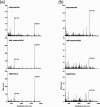Exploring protein N-glycosylation in ammonia-oxidizing Nitrososphaerota archaea through glycoproteomic analysis
- PMID: 40387319
- PMCID: PMC12153357
- DOI: 10.1128/mbio.03859-24
Exploring protein N-glycosylation in ammonia-oxidizing Nitrososphaerota archaea through glycoproteomic analysis
Abstract
Ammonia-oxidizing archaea of the phylum Nitrososphaerota, formerly known as Thaumarchaeota, are globally distributed and play critical roles in the nitrogen and carbon cycles, particularly in environments with low ammonia concentrations. Like most archaea, Nitrososphaerota cells are enveloped by S-layer proteins, implicated in concentrating ammonium ions. These proteins are typically modified post-translationally by N-glycans, which often play significant roles in various biological processes, including protein function regulation, protection from phages, and environmental adaptation. Nevertheless, the glycobiological characteristics of Nitrososphaerota remain largely unexplored. Here, we investigated the glycoproteome of ammonia-oxidizing Nitrososphaerota, specifically focusing on the terrestrial Nitrososphaera viennensis and the marine Nitrosopumilus piranensis. Both species exhibited similar protein arrays throughout their growth phases, including those associated with N-glycosylation. Ns. viennensis consistently exhibited N-glycosylation predominantly on an S-layer protein and multicopper oxidase domain-containing proteins throughout all growth phases, with a marked increase during and after the late exponential phase. The glycan, characterized as a novel hexasaccharide with a chitobiose core, is hypothesized to play a role in nitrogen storage due to its probable nitrogen-rich composition, modifying asparagine residues within the conserved triplet sequence (Asn-X-Ser or -Thr). In contrast, Np. piranensis also showed a high abundance of S-layer protein but displayed no apparent N-glycosylation on any protein, suggesting variability in cell surface physical properties between these archaea. Despite similarities in their proteomes and energy metabolism, these two archaea exhibited significant differences in post-translational modification of proteins, revealing previously unrecognized diversity that may have implications for understanding their adaptive transitions to diverse environments.
Importance: Autotrophic ammonia-oxidizing archaea of the phylum Nitrososphaerota, formerly known as Thaumarchaeota, are notoriously difficult to culture yet play important roles in the global nitrogen and carbon cycles. Inhabiting environments with extremely low ammonia concentrations, these archaea are expected to conserve ammonia strictly for energy production. However, using advanced liquid chromatography-tandem mass spectrometry and nuclear magnetic resonance techniques, we discovered that one of these archaea decorates its cell surface proteins with the most nitrogen-rich glycan identified to date, suggesting a previously unrecognized function of protein glycosylation in nitrogen storage. This newly identified N-glycan, with a chitobiose core similar to those in Thermoproteota and eukaryotes, not only deepens our understanding of archaeal evolution but also underscores the molecular adaptations enabling these archaea to thrive in diverse environments.
Keywords: Nitrososphaerota; S-layer; Thaumarchaeota; ammonia-oxidizing archaea; glycan.
Conflict of interest statement
The authors declare no conflict of interest.
Figures





Similar articles
-
N-linked protein glycosylation in Nanobdellati (formerly DPANN) archaea and their hosts.J Bacteriol. 2024 Sep 19;206(9):e0020524. doi: 10.1128/jb.00205-24. Epub 2024 Aug 28. J Bacteriol. 2024. PMID: 39194224 Free PMC article.
-
Proteomics and comparative genomics of Nitrososphaera viennensis reveal the core genome and adaptations of archaeal ammonia oxidizers.Proc Natl Acad Sci U S A. 2016 Dec 6;113(49):E7937-E7946. doi: 10.1073/pnas.1601212113. Epub 2016 Nov 18. Proc Natl Acad Sci U S A. 2016. PMID: 27864514 Free PMC article.
-
Distinct gene set in two different lineages of ammonia-oxidizing archaea supports the phylum Thaumarchaeota.Trends Microbiol. 2010 Aug;18(8):331-40. doi: 10.1016/j.tim.2010.06.003. Epub 2010 Jul 2. Trends Microbiol. 2010. PMID: 20598889
-
N-glycosylation in Archaea-New roles for an ancient posttranslational modification.Mol Microbiol. 2020 Nov;114(5):735-741. doi: 10.1111/mmi.14569. Epub 2020 Jul 26. Mol Microbiol. 2020. PMID: 32633872 Review.
-
Nitrogen metabolism and kinetics of ammonia-oxidizing archaea.Methods Enzymol. 2011;496:465-87. doi: 10.1016/B978-0-12-386489-5.00019-1. Methods Enzymol. 2011. PMID: 21514476 Review.
Cited by
-
Microbiome Diversity and Dynamics in Lotus-Fish Co-Culture Versus Intensive Pond Systems: Implications for Sustainable Aquaculture.Biology (Basel). 2025 Aug 20;14(8):1092. doi: 10.3390/biology14081092. Biology (Basel). 2025. PMID: 40906400 Free PMC article.
References
MeSH terms
Substances
Grants and funding
- JP 16H04843/Japan Society for the Promotion of Science
- JP 20H03322/Japan Society for the Promotion of Science
- 24EXC601/Exploratory Research Center on Life and Living Systems, National Institutes of Natural Sciences
- 22EXC601/Exploratory Research Center on Life and Living Systems, National Institutes of Natural Sciences
- JPMXP1323015488/Ministry of Education, Culture, Sports, Science and Technology
LinkOut - more resources
Full Text Sources
Miscellaneous

